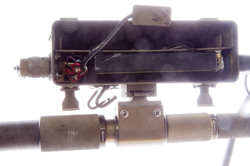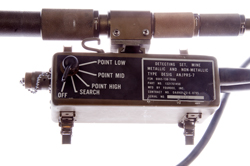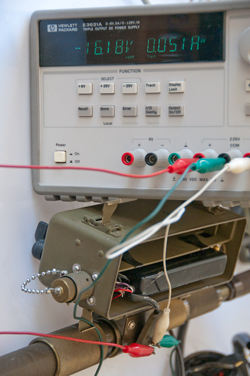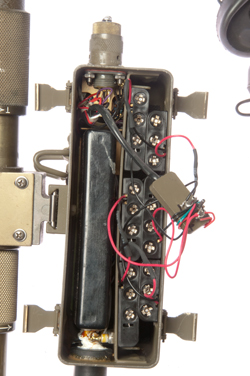PRS-7 Portable Mine Detecting Set Metallic and Non-metallic
© Brooke Clarke 2014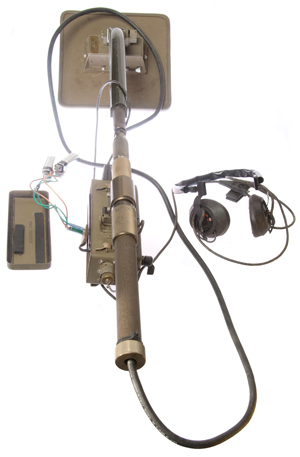
Operation
Description
Photos
Battery
AAA Battery Pack
Manuals
Related
Links
Background
I'm not sure if the PSS-11 Detecting Set, Mine is a newer, contemporary, or older mine detector. In any case this detector is supposed to detect both metallic and non-metallic mines and so it would be interesting to learn if it can detect PVC pipes in my yard.
Operation
Setup
Adjust handles to your liking.
Pre Operation Check
Set to Search.
Hold coil up about 5 feet and clear of objects.
You should hear a steady tone.
Move search head back and forth over an object and note change in tone.
Repeat above steps with switch in all other operating positions.
Sweeping for mines
Set to Sweep Mode.
Move head slowly (5 feet in 3 seconds) back and forth and listen.
If the tone gets slightly louder there may be a mine.
Outline Mine Shape
Switch from Search to Point High (or other Point setting for comfortable headset volume).
You will hear a sharp decrease in amplitude at edge of and over the top of mine.
Description
PRS-7
The head contains a fixed frequency oscillator at 394 MHz which drive a pair of transmit antennas 180 degrees out of phase by means of a BALUN transformer.
The receiving antenna is located at the null between the two transmit antennas and normally has a small output.
But when there is distortion of the transmit balance, like by the presence of a mine the output increases.
All the op amps are 709 powered by +15 and -15 Volts. All the signal processing is analog.
This is a "golden age" design that has a chance of being repaired.MIL-D-52634
PRS-8
The PRS-8 uses an antenna assembly similar to the PRS-7 except the oscillator can be tuned between 300 and 600 MHz that is chopped at 50 kHz to provide an AC signal for the LOG amp. The output of the LOG amp is converted to an analog signal that's passed to the control box.
The control box uses an A/D converter to feed the Rx signal to a micro controller.
The microcontroller drives a D/A converter that sets the frequency of the transmitter and generates a "click" output for the headphones.
Note the only control is an On/Off switch.
This is a post "golden age" design that's virtually impossible to repair if anything happened to the microcontroller.
PRS-7 Photos
Battery
There are a number of possible primary batteries, but as far as I can tell all of them are very hard if not impossible to find. It's a dual battery with a common ground and +16.2 V and -16.2 V outputs. When looking at the socket on the battery the upper left terminal is +, the lower center terminal is ground and the upper right terminal is -.
The schematic shows the battery supplying plus and minus 15 volts, so the 16.2 V number indicates a very fresh battery and the standard integrated circuit voltages of +15/-15 are what supplies the op amp inside.
The battery life should be 28 hours. When the battery voltage gets down to 10.8 Volts it is dead (para 4.2b.2) signaled by a clicking tone in the headset. This is what I'm hearing when a pair of 9V batteries are used to power the detector and so is NOT a way to properly power it.
Note the PRS-8 which is covered in the same manual uses a completely different battery (BA-5847 B/U) which will not work in the PRS-7.
Nomenclature
Mfg
NSN
Chemistry
BA-1844/U Mallory
Duracell
90303
6135-00-461-3590 Mercury
1217E1498 Cecom LR Center
97403"
303832 Mallory
Duracell
90303"
SR4163-1 Mallory
Duracell
90303"
The battery is 6" x 3/4" x 2-5/8" and weighs 14 oz.
The Arctic battery kit makes use of the same battery in a pouch and a cable that connects to the 6 terminal test/battery connector.
I'm looking into how to make a battery and/or battery adapter to power this unit.
Because the -16.2 V rail pulls 51 mA using coin cell batteries may not be a good idea. The +16.2 V rail only pulls 16 ma.
The 709 op amp has an absolute maximum specification of +&- 18 Volts so using a couple of 9V batteries for each rail would be too much because a fresh 9V battery is more than 9V so two of them would be more than 18V. Some ideas are use a bunch of 1.5V Alkaline AAA batteries or use fewer larger cells and a Switching Mode Power Supply to boost the voltage to 16.2V. It depends on what will fit into the battery outline.
LR44
A stack of 22 each LR44 button cells with a tap in the center might be used. But these are rated at 105 mAh when the load is 230 micro amps (0.23 mA).
Since the negative rail of the PRS-7 draws over 50 mA (over 200 times the rated current) the expected life will be less than 105 mAh/200 or less than 30 minutes, maybe less than 15 minutes. So this may not be the best idea.
AA Batteries
AA cells offer the newest battery chemistry and are available anywhere in the world so are a desirable option. But there is not enough room to fit 22 AA cells in the space available.
AAA Batteries
These will fit when battery holders are used. I have some holders on order to see. This allows using Alkaline cells from local stores.
The capacity of an Alkaline AAA battery is about 1,000 mAh at 50 mA load providing about 20 hours of use. This is a typical run time for military batteries.
Another option is to use a string rechargeable AAA batteries made up of 4 cell packs and 3 cell packs or individual cells with tabs that can be soldered. This will easily fit into the required space and provide about 700 mAh of capacity.
Commercial AAA battery holders do fit (June 10, 2014). They are Comfortable Electronic models: BH441A (4 cell wires) and BH431A (3 cell wires). By using two of the 4-cell and one of the 3-cell battery holders in each string you get 11 cells in each string for a voltage of 16.5 for Alkaline batteries.
In order to get the battery holders to fit (1) the two leaf springs that were to hole the military battery were removed and (2) the two 3-cell holders were positioned so that they were to the outside ends and are stopped from being closer to the ends by the heads of the rivets that hold the clamps. So there are three 4-cell holders near the electronics module and one 4-cell holder on the center outside.
The wires on the battery adapters use fine stranded wire which will not easily make contact to the plug, so solid #22 hookup wire with an inch or so stripped was wrapped around each plug pin and the insulated part of the wire wrapped around the plug to keep the wire from slipping off. This was soldered to the wires from the battery pack.
AAAA Batteries
Many 9V batteries contain six of these very small cells. You probably can fit 33 of them in the space available.
The advantage of using this option would be to use 22 cells for the negative supply ( two strings of 11 cells in parallel) and a single string of 11 cells for the positive supply. This way the life of each supply would be about the same. In all of the above ideas when the positive supply goes dead the negative supply still have half of it's capacity. With battery holders you could just replace the negative supply cells and keep using the positive cells, but with a soldered or tab welded battery you would only be using half the capacity of the positive cells.
The disadvantage is they are very small and hard to work with and not available as AAAA cells. That's to say you need to open up 9V batteries to get them.
Manuals
TM 5-6665-293-13&P Operator's, Organizational and Direct Support Maintenance Manual Including Repair Parts and Special Tools List,
Detecting Set, Mine, Portable, Metallic and Nonmetallic, AN/PRS-7 (Littion Systems Model MMN, NSN 6665-00-179-5120)
and
(Fourdee Model 4D6000, NSN 6665-00-138-7998)
21 November 1980, with Change 1 10 June 1982 incorporated
Related
PSS-11 Detecting Set, Mine
Sensors
Links
Brooke's: PRC68, Alphanumeric Index of Web Pages, Products for SalePage Created 20 May 2014
